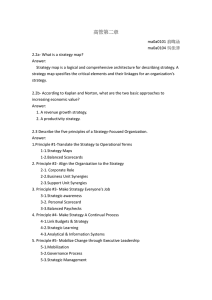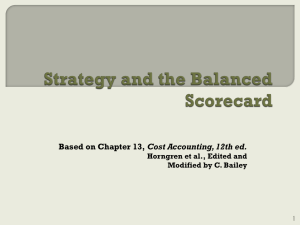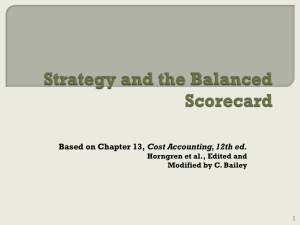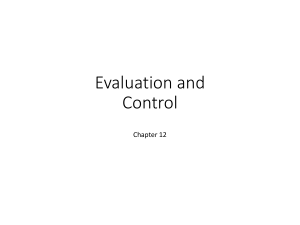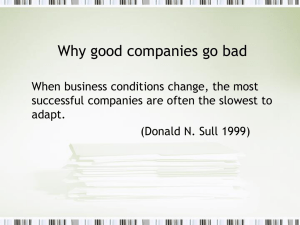performance measurement
advertisement
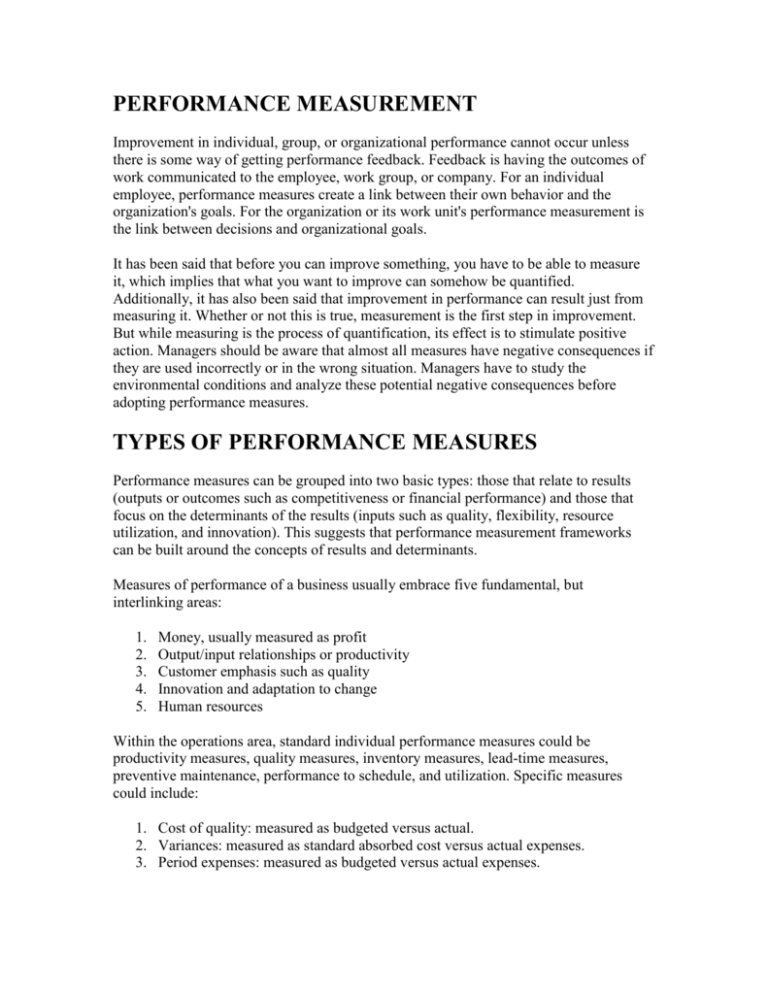
PERFORMANCE MEASUREMENT Improvement in individual, group, or organizational performance cannot occur unless there is some way of getting performance feedback. Feedback is having the outcomes of work communicated to the employee, work group, or company. For an individual employee, performance measures create a link between their own behavior and the organization's goals. For the organization or its work unit's performance measurement is the link between decisions and organizational goals. It has been said that before you can improve something, you have to be able to measure it, which implies that what you want to improve can somehow be quantified. Additionally, it has also been said that improvement in performance can result just from measuring it. Whether or not this is true, measurement is the first step in improvement. But while measuring is the process of quantification, its effect is to stimulate positive action. Managers should be aware that almost all measures have negative consequences if they are used incorrectly or in the wrong situation. Managers have to study the environmental conditions and analyze these potential negative consequences before adopting performance measures. TYPES OF PERFORMANCE MEASURES Performance measures can be grouped into two basic types: those that relate to results (outputs or outcomes such as competitiveness or financial performance) and those that focus on the determinants of the results (inputs such as quality, flexibility, resource utilization, and innovation). This suggests that performance measurement frameworks can be built around the concepts of results and determinants. Measures of performance of a business usually embrace five fundamental, but interlinking areas: 1. 2. 3. 4. 5. Money, usually measured as profit Output/input relationships or productivity Customer emphasis such as quality Innovation and adaptation to change Human resources Within the operations area, standard individual performance measures could be productivity measures, quality measures, inventory measures, lead-time measures, preventive maintenance, performance to schedule, and utilization. Specific measures could include: 1. Cost of quality: measured as budgeted versus actual. 2. Variances: measured as standard absorbed cost versus actual expenses. 3. Period expenses: measured as budgeted versus actual expenses. 4. Safety: measured on some common scale such as number of hours without an accident. 5. Profit contribution: measured in dollars or some common scale. 6. Inventory turnover: measured as actual versus budgeted turnover. While financial measures of performance are often used to gauge organizational performance, some firms have experienced negative consequences from relying solely on these measures. Traditional financial measures are better at measuring the consequences of yesterday's actions than at projecting tomorrow's performance. Therefore, it is better that managers not rely on one set of measures to provide a clear performance target. Many firms still rely on measures of cost and efficiency, when at times such indicators as time, quality, and service would be more appropriate measures. To be effective, performance yardsticks should continuously evolve in order to properly assess performance and focus resources on continuous improvement and motivating personnel. In order to incorporate various types of performance measures some firm's develop performance measurement frameworks. These frameworks appear in the literature and vary from Kaplan and Norton's balanced scorecard to Fitzgerald's framework of results and determinants. Kaplan and Norton's balanced scorecard approach operates from the perspective that more than financial data is needed to measure performance and that nonfinancial data should be included to adequately assess performance. They suggest that any performance measurement framework should allow managers to ask the following questions: How do we look to our shareholders? (financial perspective) What must we excel at? (internal business perspective) How do our customers see us? (customer perspective) How can we continue to improve and create value? (innovation and learning perspective) However, the balanced scorecard is flawed as it does not allow for one of the most important questions of all: • What are our competitors doing? (the competitor perspective) Keegan proposed a similar, but lesser known, performance measurement framework titled the "performance matrix." The performance matrix is more flexible, as it is able to integrate different dimensions of performance, and employs generic terms such as internal, external, cost, and noncost. DESIGNING THE PERFORMANCE MEASUREMENT SYSTEM A number of suggestions have been offered by various experts on the subject of designing performance measurement systems. Below is a list of suggestions derived from a number of these experts. Some of these apply to all measures and some apply to a limited number of a firm's measures. A firm's performance measures should: Be simple and easy to use. Have a clear purpose. Provide fast feedback. Cover all the appropriate elements (internal, external, financial and nonfinancial). Relate to performance improvement, not just monitoring. Reinforce the firm's strategy. Relate to both long-term and short-term objectives of the organization. Match the firm's organization culture. Not conflict with one another. Be integrated both horizontally and vertically in the corporate structure. Be consistent with the firm's existing recognition and reward system. Focus on what is important to customers. Focus on what the competition is doing. Lead to identification and elimination of waste. Help accelerate organizational learning. Help build a consensus for change when customer expectations shift or strategies and priorities call for the organization to behave differently. Evaluate groups not individuals for performance to schedule. Establish specific numeric standards for most goals. Be available for constant review. Other recommendations for organizations that are developing performance measures include: 1. Data collection and methods of calculating the performance measure must be clearly defined. 2. Objective performance criteria are preferable to subjective ones. 3. Recognize that measures may vary between locations; avoid a "one size fits all" mentality. Wisner and Fawcett provide a nine-step process for developing a performance measurement system: 1. Clearly define the firm's mission statement. 2. Identify the firm's strategic objectives using the mission statement as a guide (profitability, market share, quality, cost, flexibility, dependability, and innovation). 3. Develop an understanding of each functional area's role in achieving the various strategic objectives. 4. For each functional area, develop global performance measures capable of defining the firm's overall competitive position to top management. 5. Communicate strategic objectives and performance goals to lower levels in the organization. Establish more specific performance criteria at each level. 6. Assure consistency with strategic objectives among the performance criteria used at each level. 7. Assure the compatibility of performance measures used in all functional areas. 8. Use the performance measurement system to identify competition, locate problem areas, assist the firm in updating strategic objectives and making tactical decisions to achieve these objectives, and supply feedback after the decisions are implemented. 9. Periodically reevaluate the appropriateness of the established performance measurement system in view of the current competitive environment. Finally, it is important that the performance measurement systems used by managers be continually reviewed and revised as the environment and economy changes. Failure to make the necessary modifications can inhibit the ability of the organization to be an effective and efficient global competitor. SEE ALSO: Balanced Scorecard; Employee Evaluation and Performance Appraisals; Human Resource Management; Quality and Total Quality Management R. Anthony Inman Revised by Marcia Simmering
